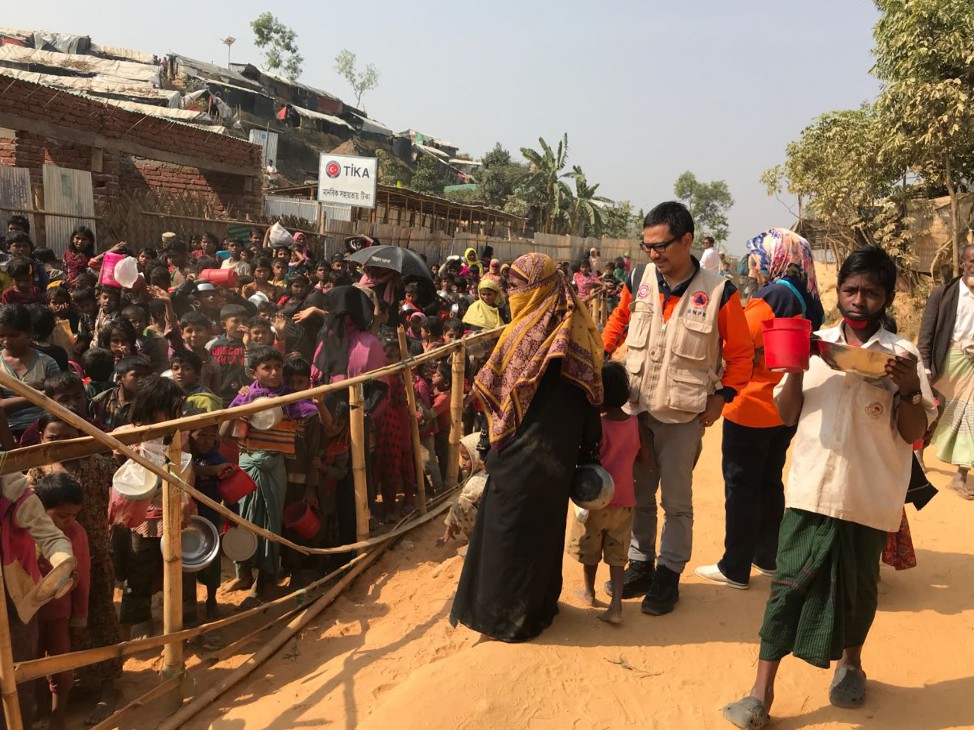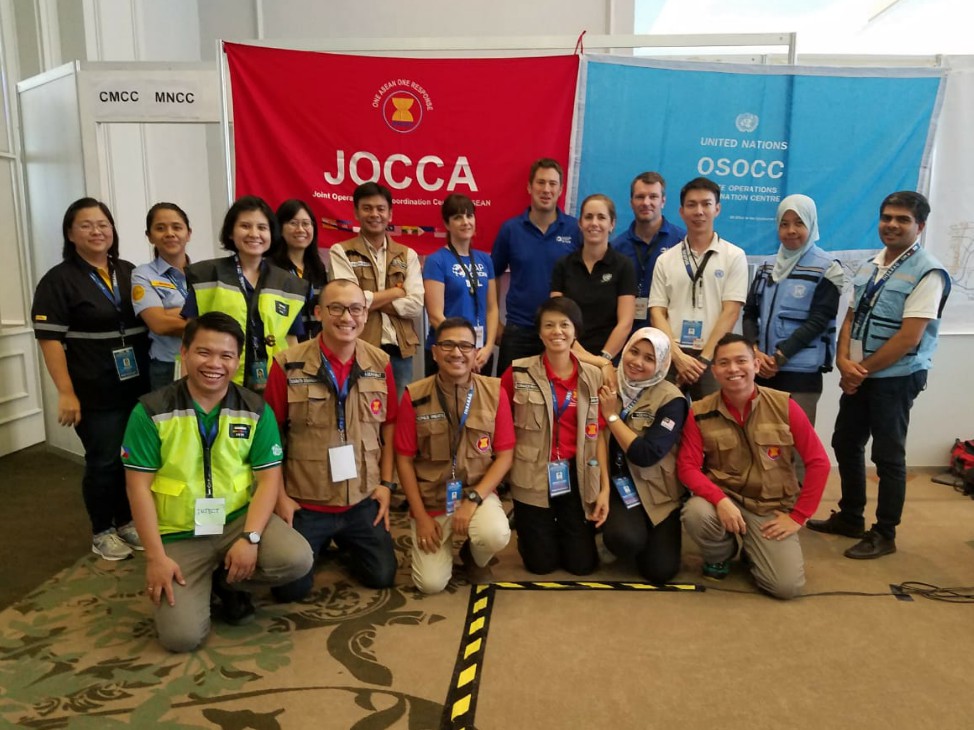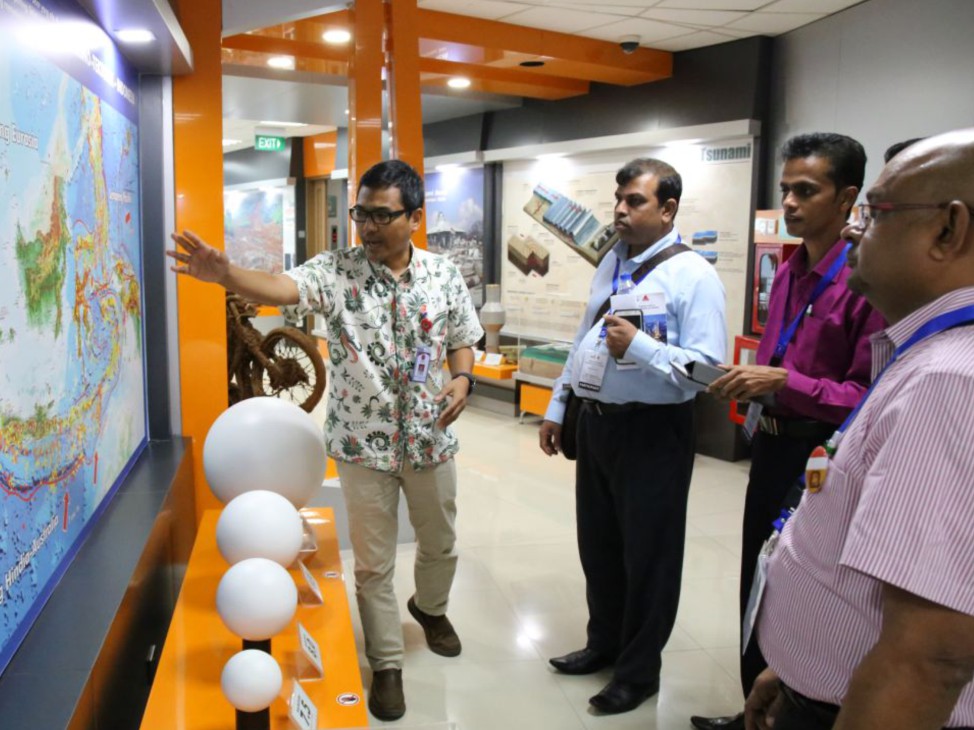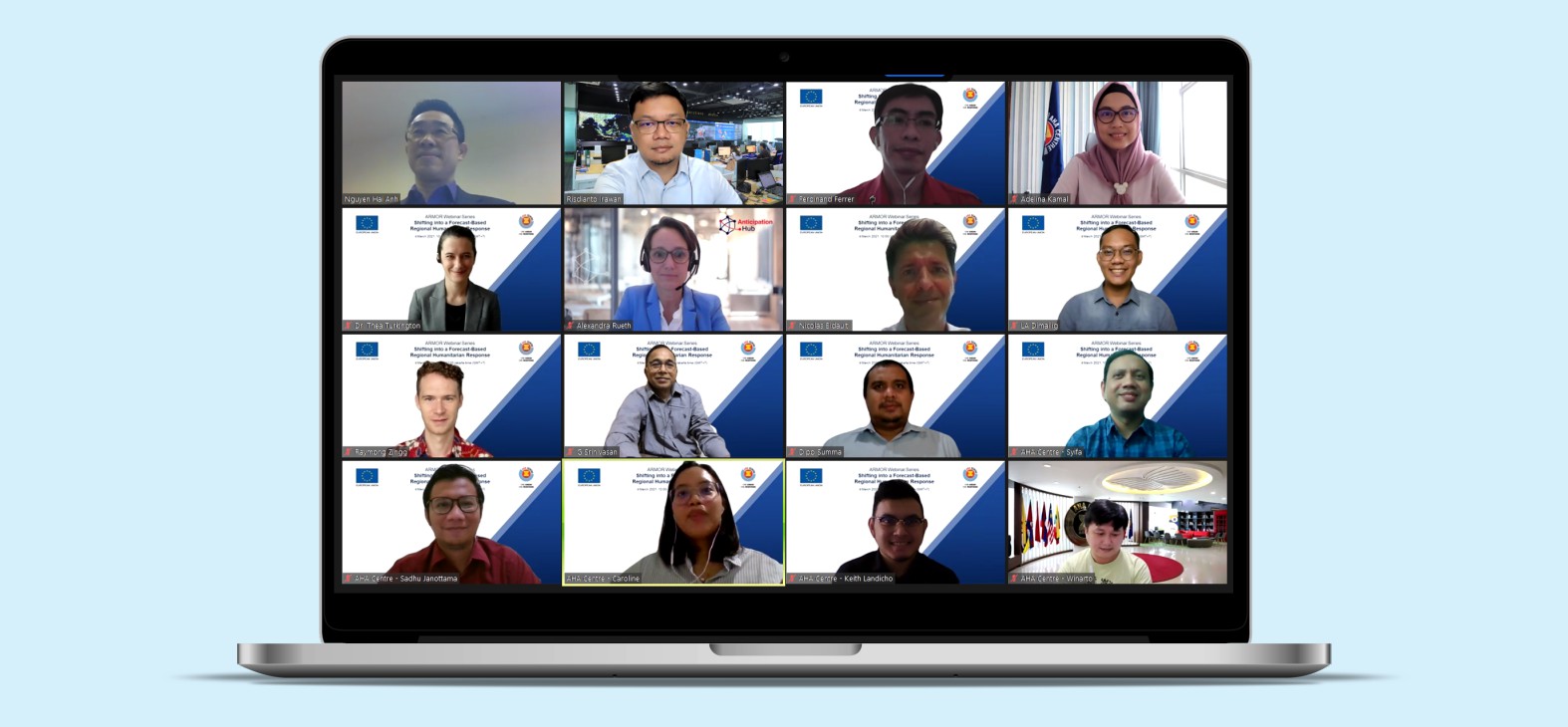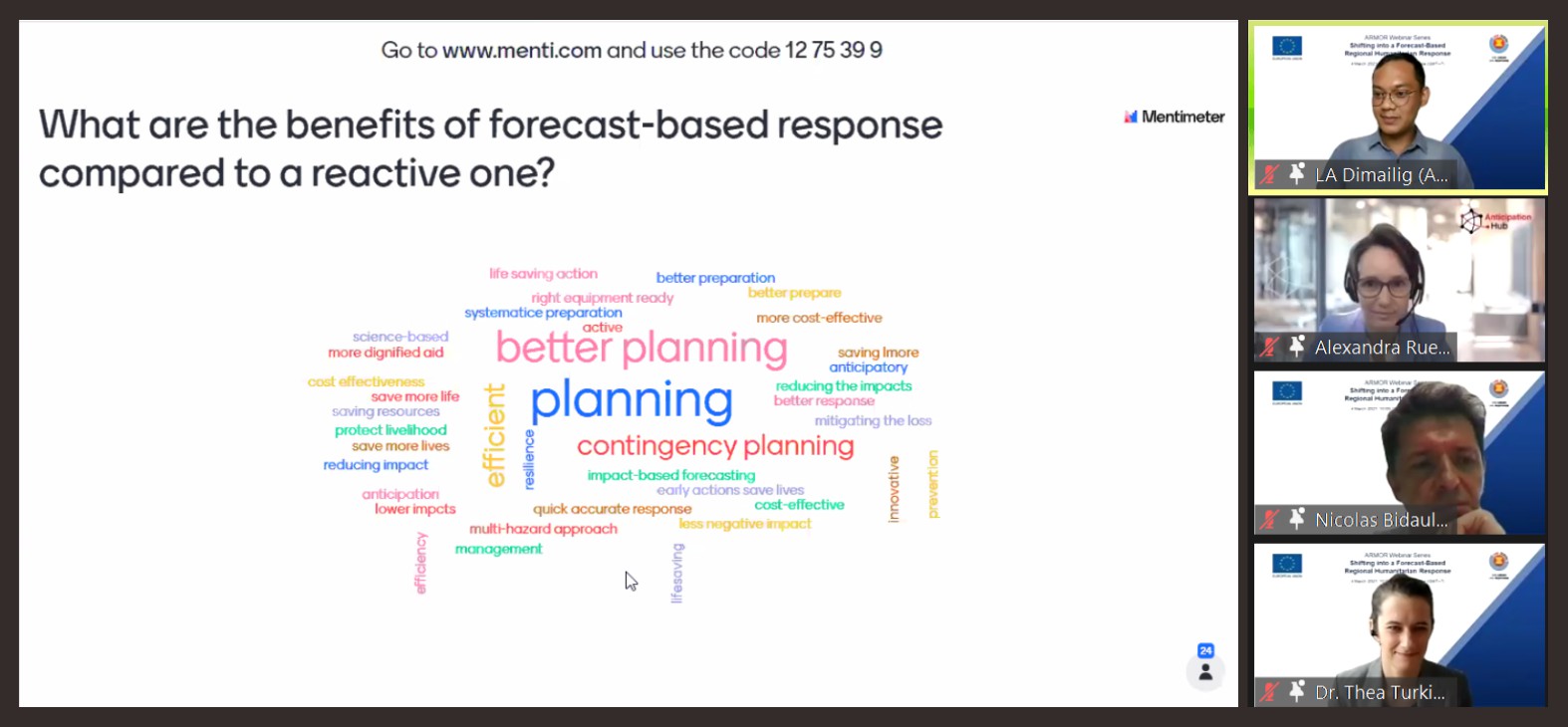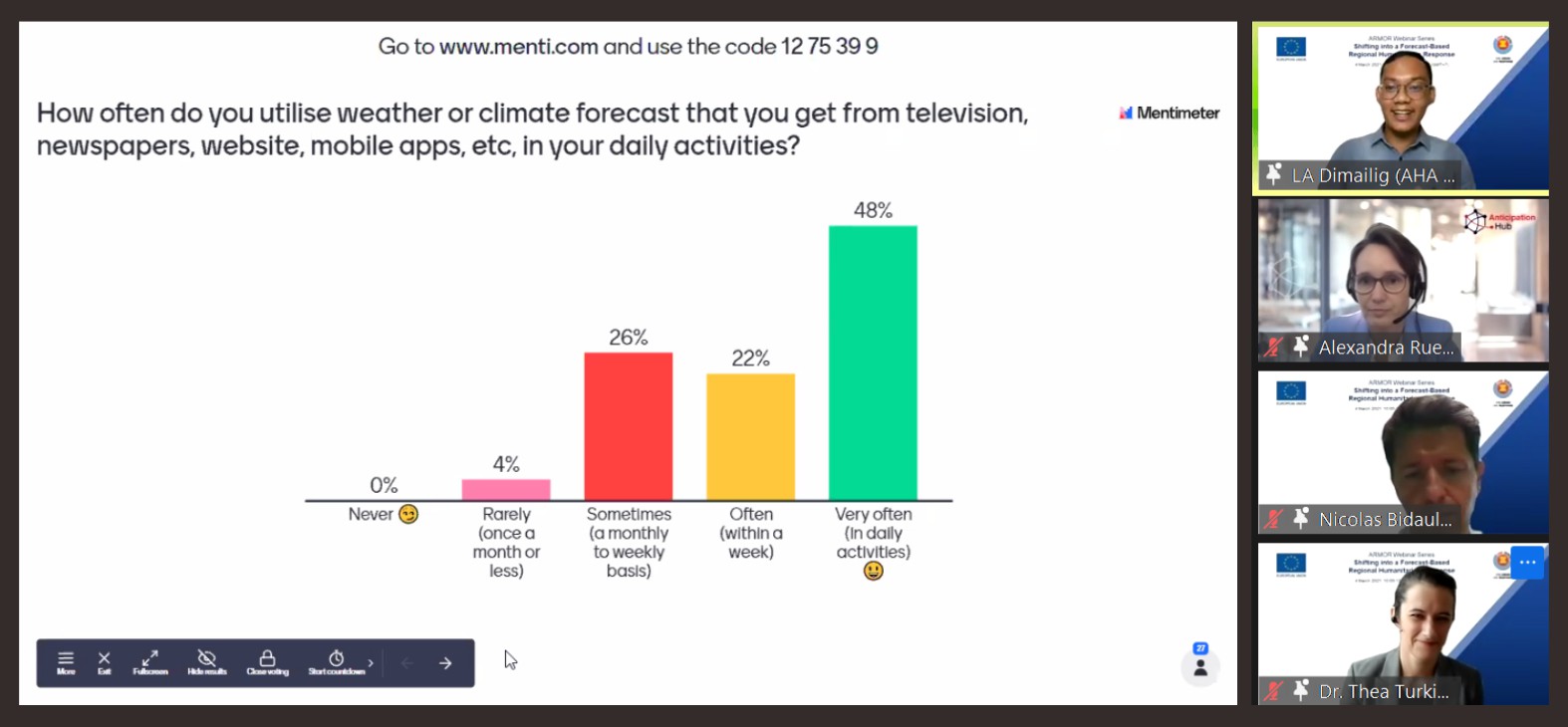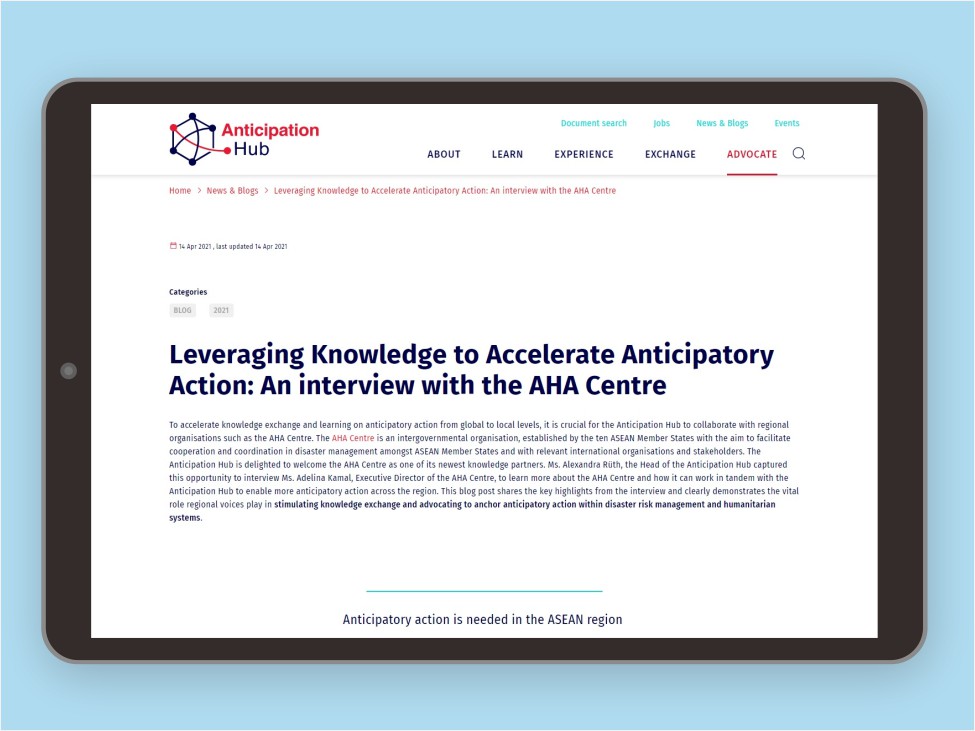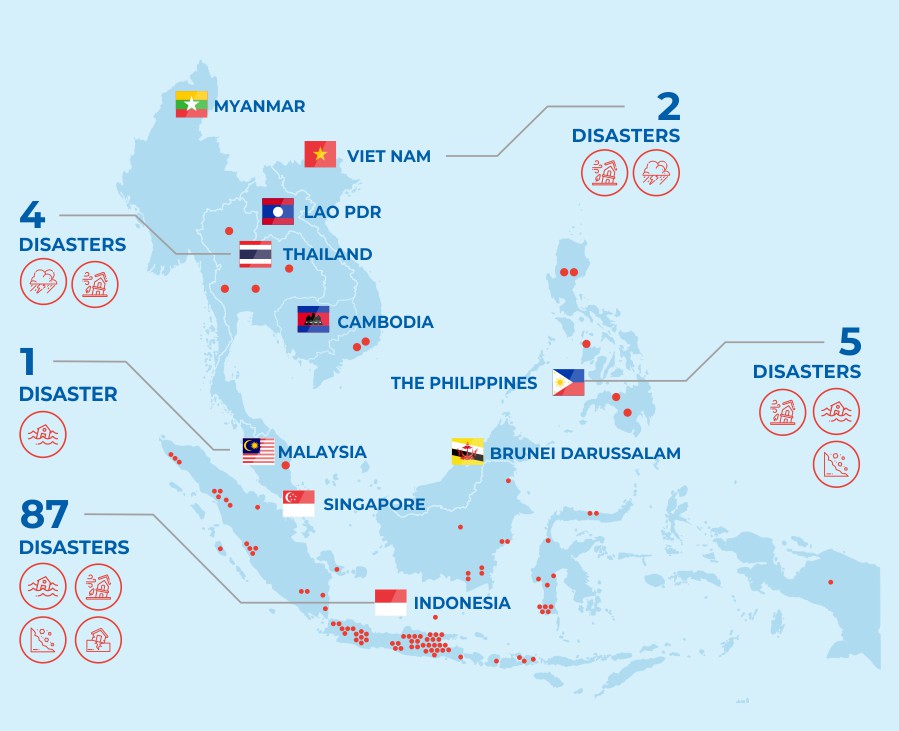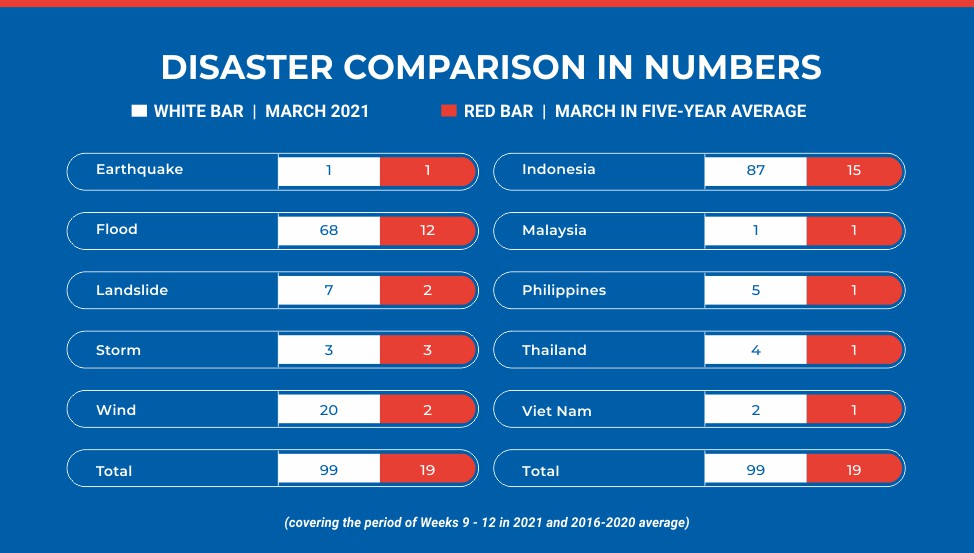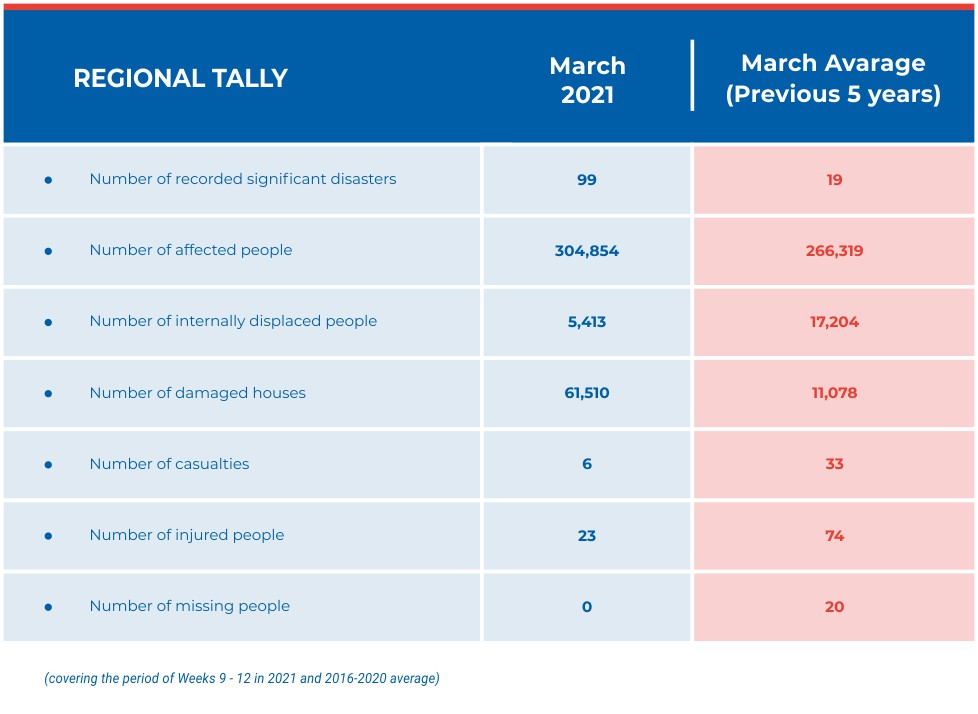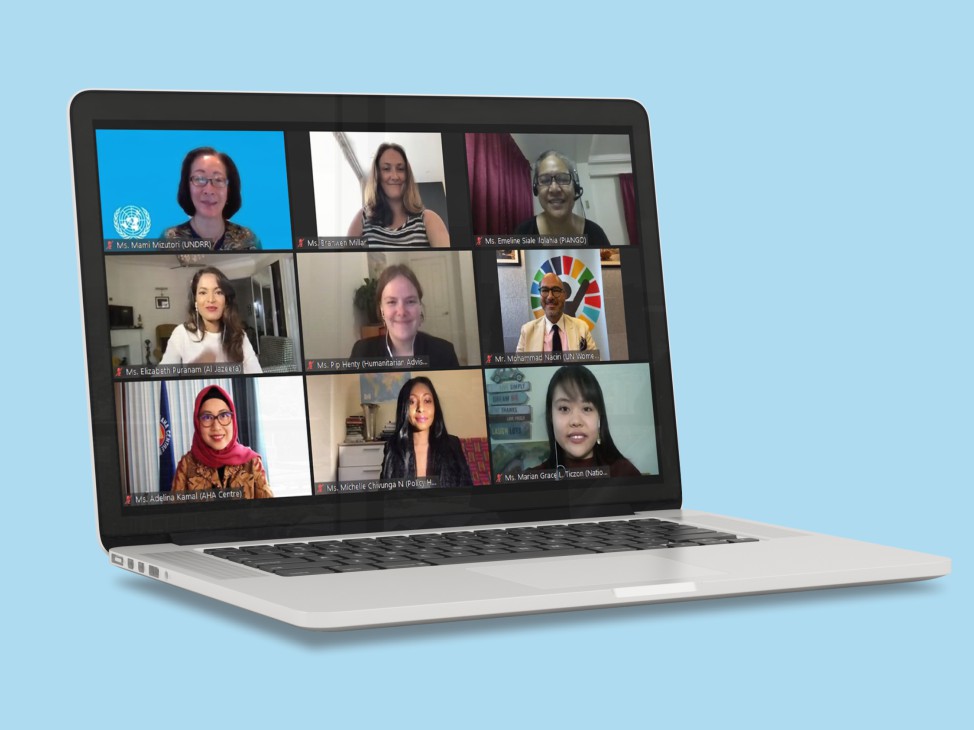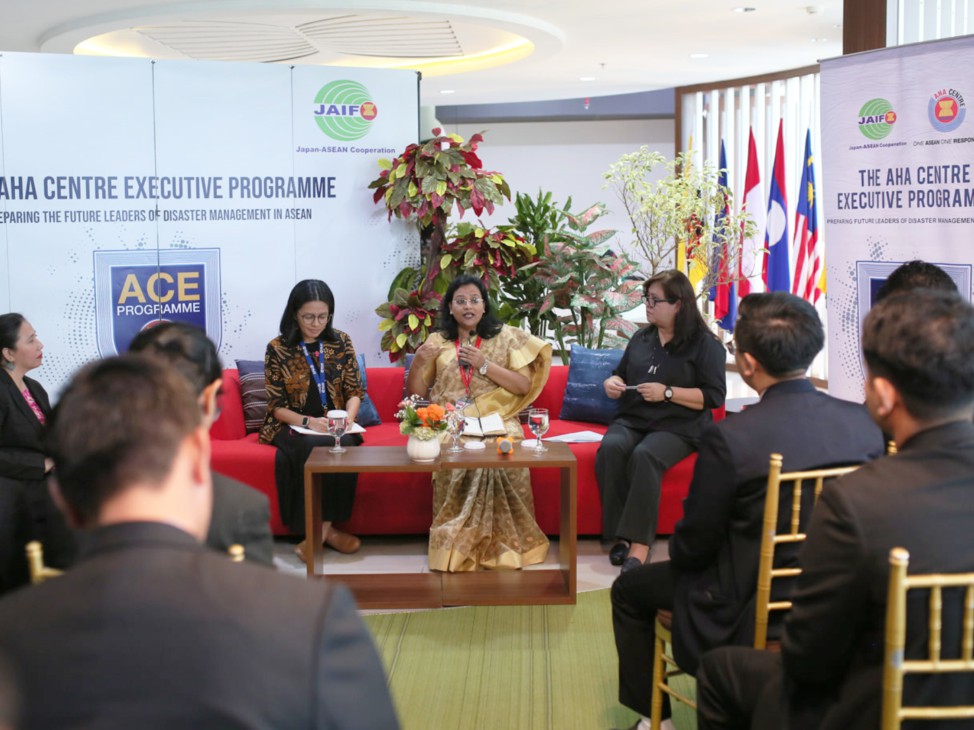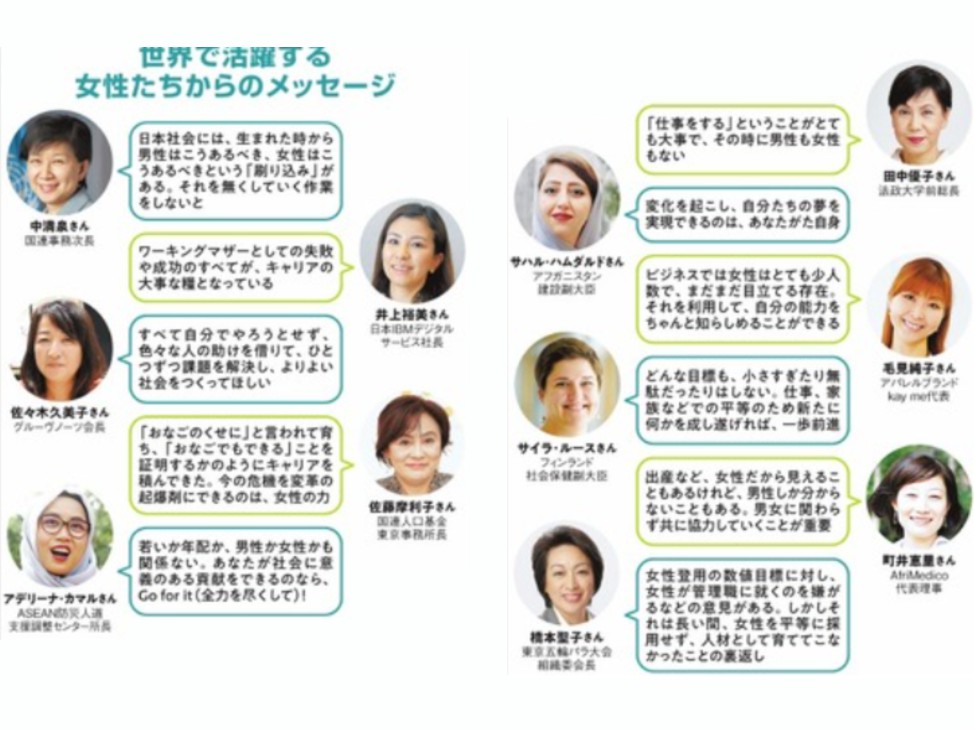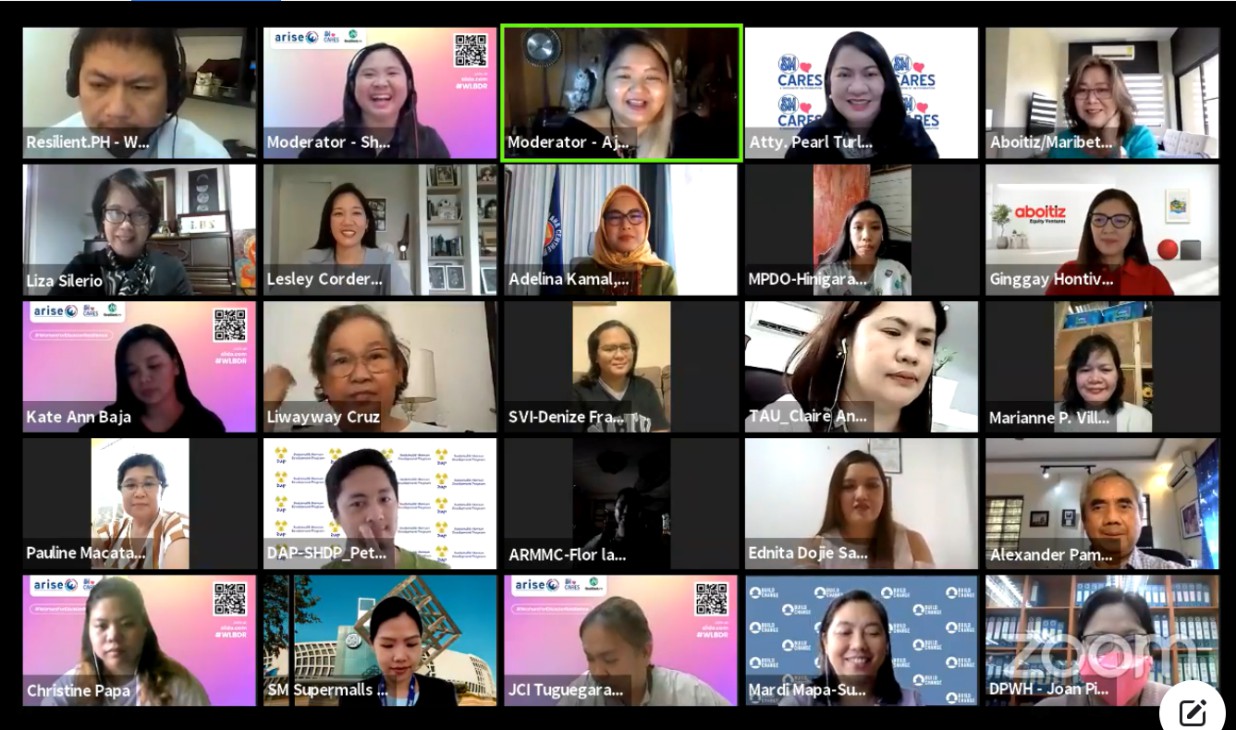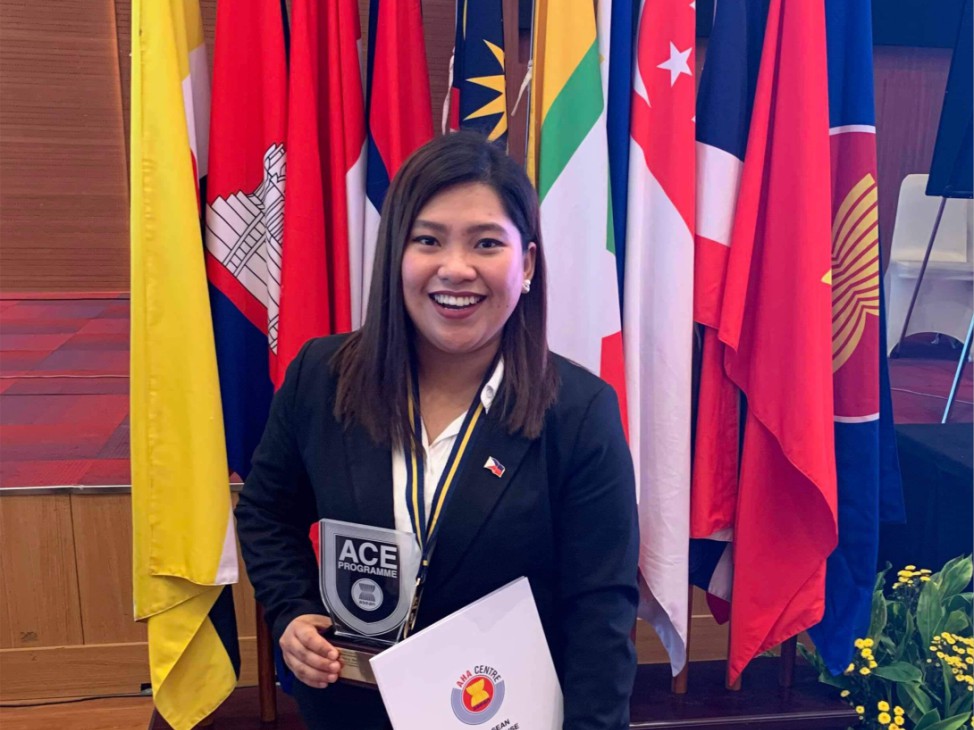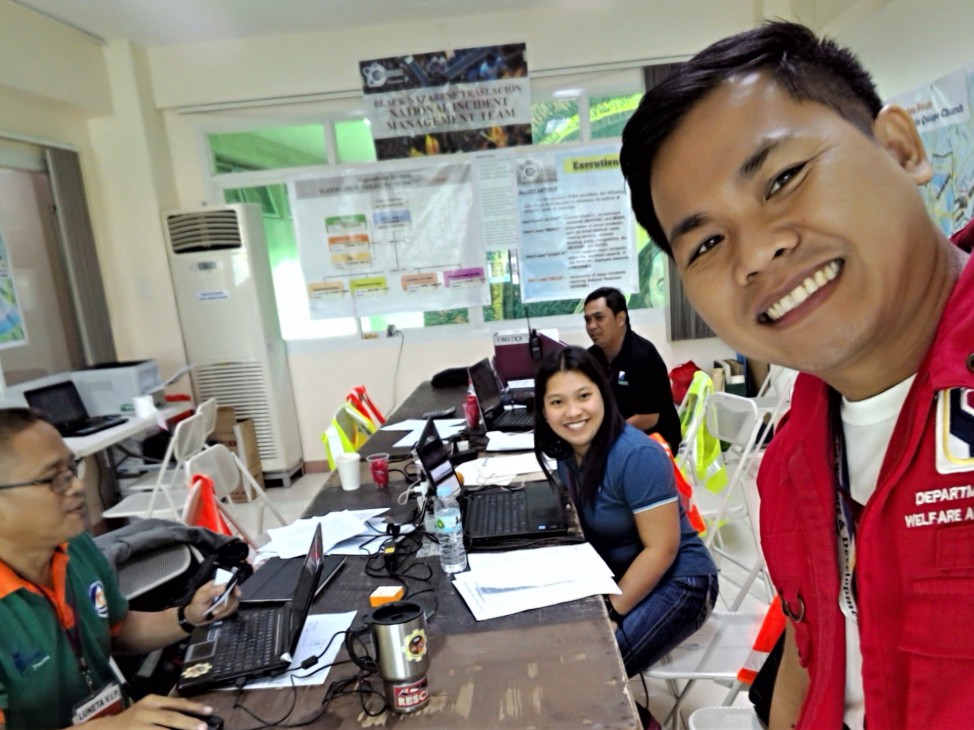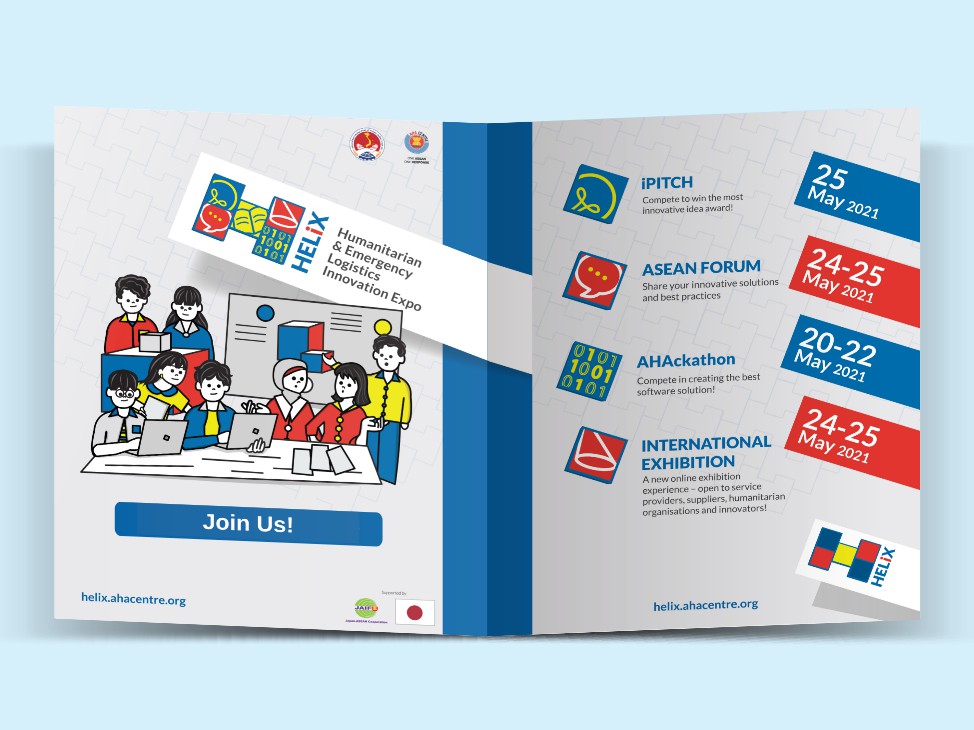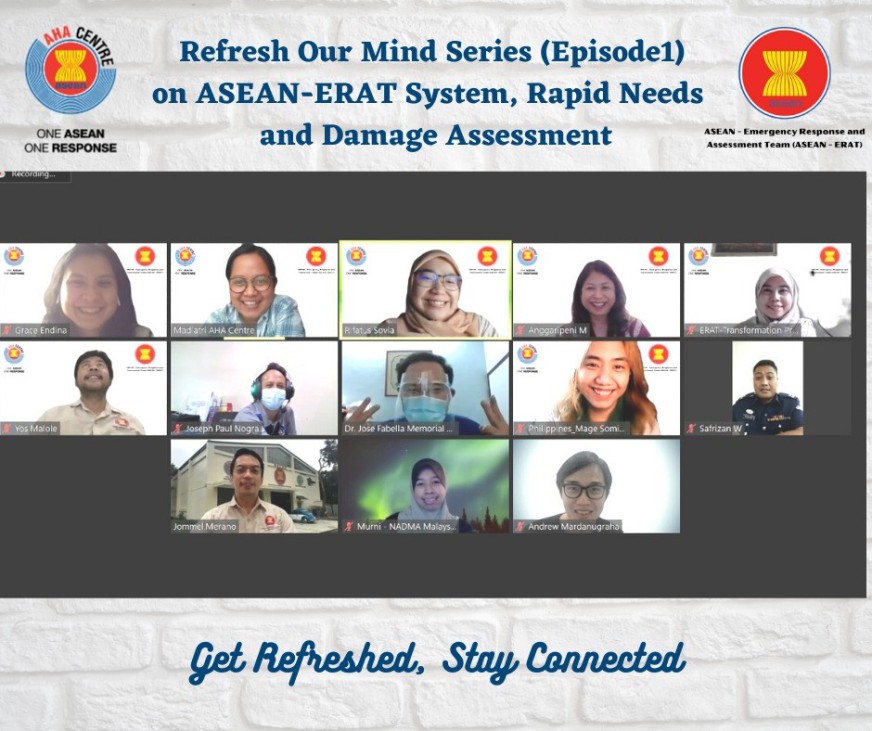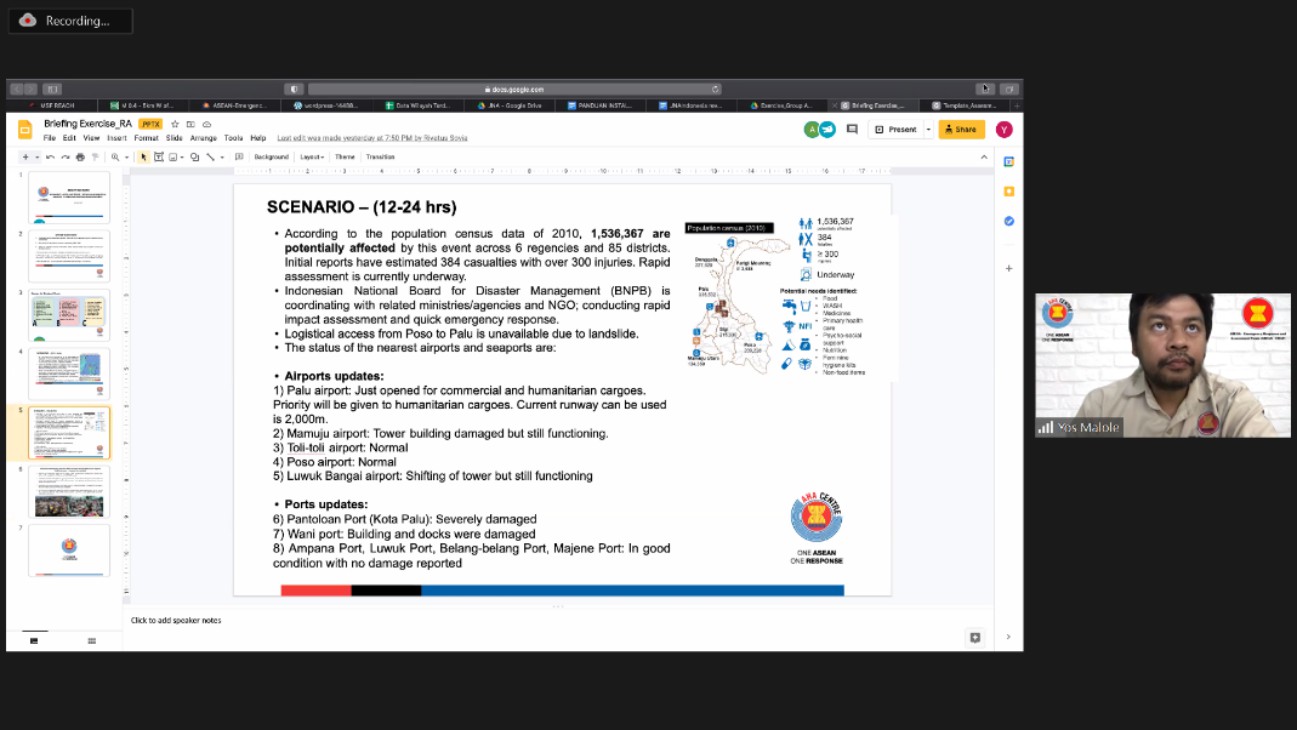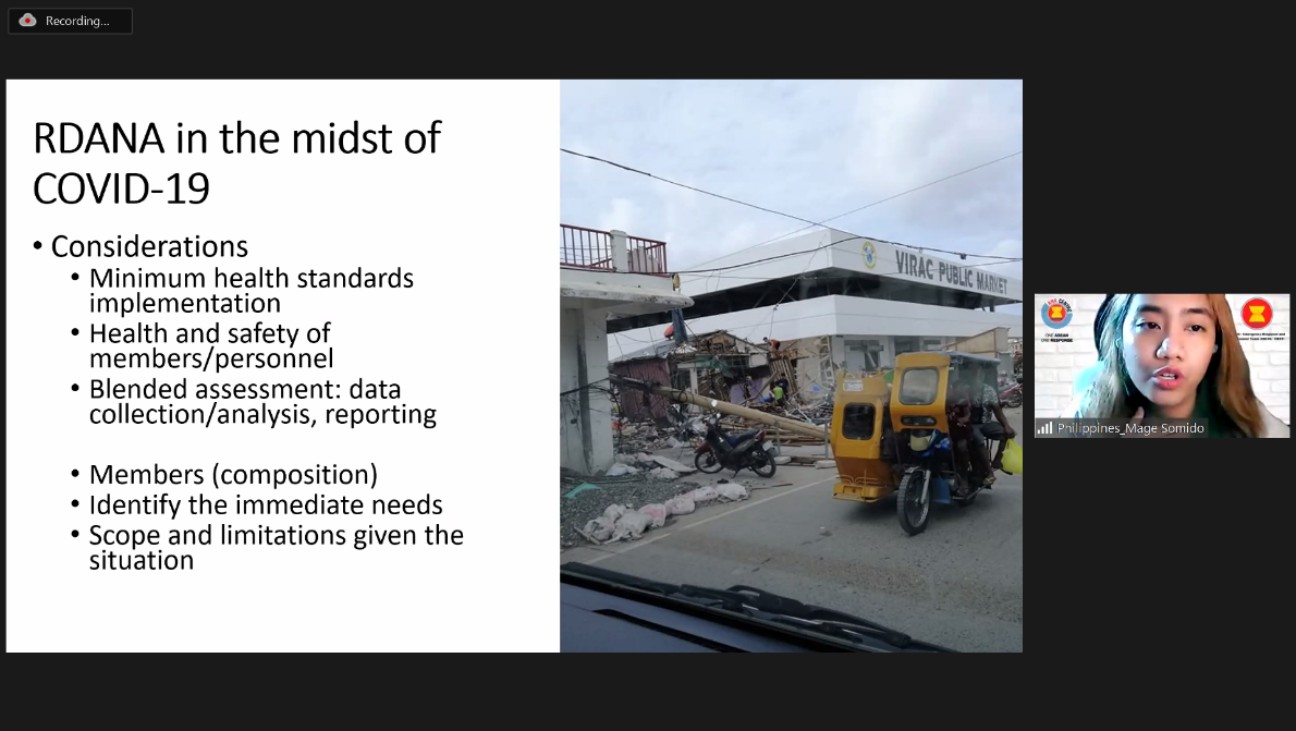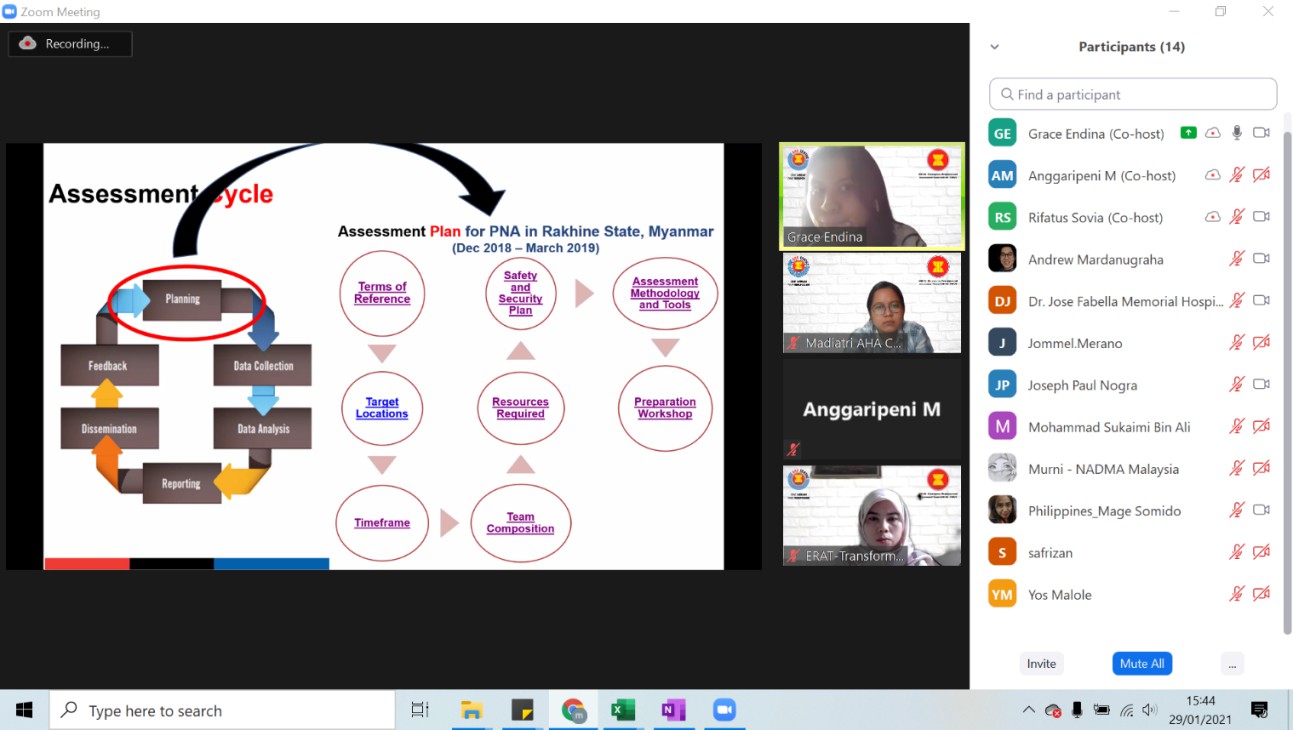Vol 71 – THEOPHILUS YANUARTO

THEOPHILUS YANUARTO
Communication and information are integral elements of disaster management, and are becoming even more important as the digital era expands. This month we speak with Theophilus Yanuarto in his role as the Supervisor for Disaster Communication and Publications, in the Data, Information and Disaster Communication Centre of Indonesia’s National Disaster Management Authority (BNPB).
One of the alumni from batch 2 (2015) of the AHA Centre Executive (ACE) Programme, Mr Yanuarto explained the programme’s impact and influence on his career since his graduation. “I felt it was a very comprehensive programme that provided disaster management analysis and knowledge capabilities, including enhancing our skills in some activities”, he explained. “This programme greatly increased my capacity in various contexts, such as related to risk communication, incident command system, international humanitarian system, logistics. It also not only strengthens relations between countries but can contribute to my organisation and other relevant organisations focusing on disaster management.”
Mr Yanuarto is also a member of the ASEAN Emergency Response and Assessment Team (ERAT), and explains how his engagement in disaster responses has resulted in relevant learning for his overall work. “I learned many things when involved in emergency management in the region, ranging from the characteristics of the disaster, how the government responds, working in teams of members from several countries.” Mr Yanuarto also highlights the feeling of togetherness experienced during his role supporting the emergency response to Typhoon Mangkhut in the Philippines in 2018. “I was warmly received while at NDRRMC and communicating with colleagues there. I also saw the positive dynamics between the people working in the Emergency Operation Centre (EOC) when responding to the Typhoon Mangkhut.”
Currently, Mr Yanuarto’s role with the BNPB sees him responsible for the publicity of disasters in Indonesia. “The forms of publication can be text, audio, or video” he explained, “and are very useful for local disaster management agencies in terms of public communication in disaster-affected areas”. Within this, however, Mr Yanuarto can identify ongoing challenges that are part of disaster communication – in particular gaps between national and local-level communication capacities. “In the context of disasters, the media usually relies on information from the national level”, he explained. “However, the speed of information delivered from the affected area – information urgently needed by the community, including the media – remains a challenge.”
Looking ahead, Mr Yanuarto has high hopes for disaster management across the ASEAN region, and recognises the importance in regional cooperation in the face of disaster. “I hope the vision of One ASEAN One Response can be the catalyst for government policy related to receiving assistance from ASEAN countries”, he said.
“Each ASEAN nation has experience in disaster management – especially in the context of local knowledge – and sharing of such knowledge can enrich disaster management among ASEAN Member States.”
Written by : Moch Syifa, William Shea | Photo Credit : Theophilus Yanuarto
- Published in The Other Side
Vol 71 – ARMOR WEBINAR SERIES #3: SHIFTING INTO A FORECAST-BASED REGIONAL HUMANITARIAN RESPONSE

ARMOR WEBINAR SERIES #3:
SHIFTING INTO A FORECAST-BASED REGIONAL HUMANITARIAN RESPONSE
The third instalment of the ASEAN Risk Monitor and Disaster Management Review (ARMOR) Webinar Series focused on the topic of ‘Shifting into a Forecast-based Regional Humanitarian Response’. The webinar series is being implemented to discuss articles presented by the ARMOR 2nd Edition, with this session aiming to highlight the importance of anticipatory action in disaster management. The webinar engaged various experts and commentators from different international organisations, and was conducted in a virtual environment on 4 March 2021.
The webinar began with a discussion on the article titled When Early Actions Save Lives: Anticipating Instead of Reacting with Forecast-based Financing. Panellists in this session spoke about how Forecast-based Financing (FbF) strengthens humanitarian mandates by enabling National Societies to assist people in need more quickly and effectively. They also discussed about internal processes in becoming more agile in delivering aid and services under FbF, and the emergency response processes profiting equally – which means that FbF also contributes to the enhancement of responses.
The three panellists for the session were Mr Raymond Zingg (Regional Forecast-based Financing Coordinator for Asia Pacific of the IFRC), Mr Nguyen Hai Anh (Vice President and Secretary-General of the Viet Nam Red Cross Society), and Mr Ferdinand Ferrer (Philippine Red Cross Chapter Administrator of Camarines Norte). Mr Anh provided an example of FbF implementation in Viet Nam for heatwaves in an urban context, with the main objective of reducing the impact of heatwaves on Hanoi’s most vulnerable populations. As each heatwave can affect a large area, the organisations recognised the need to identify the most at-risk zones. Mr Ferrer shared lessons learned on developing an Early Action Protocol (EAP) for tropical cyclones in the Philippines, as the Philippine Red Cross (PRC) developed an EAP that enables the implementation of early actions focusing on the most at-risk municipalities. The EAP adapts to the local contexts of these municipalities by encouraging the strengthening of vulnerable houses, early harvesting of mature crops, and evacuation of livestock.
The second ARMOR article up for discussion was Three Weeks’ Notice: Forecasting Extreme Weather Events with Subseasonal-to-Seasonal Climate Prediction, which engaged Dr Govindarajalu Srinivasan (Chief Scientist for Climate Applications, Regional Integrated Multi-Hazard Early Warning System for Africa and Asia – RIMES), and Dr Thea Turkington (Senior Research Scientist in the Seasonal and Sub-seasonal Prediction Section, Meteorological Service Singapore). The panellists discussed the importance of considering Subseasonal-to-Seasonal (S2S) predictions as part of a broader spectrum of weather and climate products that should be utilised together to improve decision-making in the areas of preparedness and response.
Such easy-to-use decision support systems that bring together a range of weather and climate information will better enable disaster managers to put S2S into action. It was also explained that successful integration of S2S into disaster preparedness protocols can reduce disaster impacts, because the predictions from S2S have a higher update frequency than seasonal predictions, as well as longer lead time than short and medium-range weather forecasts.
All webinar participants also had the opportunity to have an interactive session with the expert panellists and commentators. Interestingly, discussing the issues related to anticipatory decision-making saw most participants agree that anticipatory action implementation also needs to be supported by the policy makers and governments. In line with this context, an announcement was also made at the beginning of the webinar related to the AHA Centre’s new collaboration with the Anticipation Hub. Ms Adelina Kamal, the Executive Director of the AHA Centre, stated that this collaboration will enable more anticipatory action across the region.
Different perspectives on both articles were provided during the event, with guest commentary offered by Alexandra Ruth (Head of the Anticipation Hub from the German Red Cross), and Nicolas Bidault (Head of Vulnerability Analysis and Mapping, UN World Food Programme Regional Bureau for Asia and the Pacific). The ARMOR Webinar Series was organised as part of the EU-SAHA project, through the support of the European Union Mission to ASEAN.
Written by: Moch Syifa | Photo Credit : AHA Centre
- Published in AHA Centre Diary 1
Vol 71 – AHA CENTRE TO COLLABORATE WITH THE ANTICIPATION HUB

AHA CENTRE TO COLLABORATE WITH THE ANTICIPATION HUB
Being prepared for disaster requires anticipating all aspects that may arise, and sees anticipatory action gathering a greater focus at the global and regional level. Recognising this, the AHA Centre is coming together with the Red Cross and Red Crescent Movement to engage with the Anticipation Hub. The Column spoke to a number of key leaders within the Anticipation Hub system to get their insights into the AHA Centre’s engagement and the values of the AHA Centre joining the Anticipation Hub.
The Anticipation Hub is an online knowledge and exchange platform that supports practitioners, scientists and policymakers to utilise anticipatory action in the humanitarian sector – with the overall aim to reduce disaster risk and adapt to climate change. Hosted by the German Red Cross in cooperation with the International Federation of Red Cross and Red Crescent Societies, the Hub is also supported by the Red Cross Red Crescent Climate Centre, with funding support from Germany’s Federal Foreign Office.
The Anticipation Hub’s Head, Alexandra Rueth told us that “collaboration between the Anticipation Hub and the AHA Centre will put into action our commitment to implementing more anticipatory action, and subsequently reducing the impacts of climate change”. “Our collective approach to sharing knowledge, exchanging experiences and joint advocacy will strengthen our capacity to reduce disaster risk and protect lives of the most vulnerable both in the ASEAN region and globally”, she explained.
The importance of the partnership was also highlighted by Jan Gelfand, the Head of Delegation, Country Cluster Delegation for Indonesia, Timor-Leste and Representative to ASEAN, when he said “The partnership will allow us to move forward together on commitments made to reduce the impact of climate change on the most vulnerable communities, enabling regional disaster management bodies such as the AHA Centre to provide effective and timely support ahead of crises”. Mr Gelfand also spoke of the role of anticipatory action across the region, by stating that “There is an increased focus of anticipatory action at regional level as well as in the AADMER Work Programme. The Anticipation Hub can offer support via trainings, concrete advocacy messages and facilitating connections with relevant stakeholders, such as research institutes and universities”. “Together we can enable the integration of anticipatory action into national disaster risk management systems” he concluded.
Providing further insight into the working value of the partnership, the Regional Forecast-based Financing Coordinator for IFRC Asia Pacific, Mr. Raymond Zingg explained the role of the parties within the hub, and how they bring value to the overall anticipatory action efforts. “The Anticipation Hub will enable further learning and exchange of practices and methodologies for enabling anticipatory action in new and emerging settings, including conflict and disease outbreaks”, Mr Zingg said, while also stating that “it will facilitate innovation between global and regional partners on topics such as impact-based forecasting for multiple hazards”.
Mr Zingg finished by saying “We want to provide faster, more effective and more dignified humanitarian assistance – the new normal is anticipatory action – and continued collaboration/ coordination and technical knowledge exchange is crucial to make this happen”. These thoughts were echoed by the AHA Centre’s Executive Director Ms Adelina Kamal when she emphasised the need for the ASEAN region to shift from reacting to anticipating disasters, especially to manage the increasing frequency, intensity and impact of disasters.
“The Anticipation Hub has a vital role to play in creating and sharing this evidence to influence behaviour change and facilitate this resulting systemic change in mind-set.”
-Ms. Adelina Kamal
Written by : Moch Syifa, William Shea
- Published in Partnership
Vol 71 – TRAVEL CORRIDOR ARRANGEMENTS: BETWEEN ECONOMIC AND HEALTH INTERESTS

TRAVEL CORRIDOR ARRANGEMENTS:
BETWEEN ECONOMIC AND HEALTH INTERESTS
An article by the AHA Centre’s own Grace Endina – a preparedness and response officer in the ASEAN Emergency Response and Assessment Team (ASEAN-ERAT) – was recently published on the Jakarta Post’s website. Named Travel corridor arrangements: Between economic and health interests, this article provides an insight into travel during the time of pandemic, and highlights areas for learning that could be utilised during this or future pandemics. The following are excerpts from Grace’s article, with the full version linked at the end of the text.
I am one of the few people who were fortunate to be able to travel amid the pandemic, flying from Jakarta to Yangon, Myanmar. Indeed, it was really challenging even before I hopped on the flight in my mask and face shield, and with my handy bottle of hand sanitizer. Thanks to the pandemic, I had to transit in Singapore and then Malaysia, due to the different procedures in each country. These included the validity period of COVID-19 test results, flight availability, sudden visa requirements and transit restrictions for passengers arriving from certain cities.
At Yangon International Airport, airport authorities and officers from the Ministry of Health strictly recorded passengers’ data and then transported them via a shuttle service to a designated quarantine hotel. Foreigners were taken to one hotel, where we were required to self-quarantine for exactly two weeks. Another interesting observation was the rather long time that passed between arriving flights at the three airports, which I guess was intended to enable airport authorities and health officials to manage and control the arrival of international travelers.
The most interesting aspect was the quarantine process and period. While some studies have suggested that the coronavirus may not be detected in the early days of exposure, each country applied different quarantine periods and different swab testing frequencies and intervals for travelers. Singapore and Myanmar, for instance, imposed a very strict quarantine period of 14 days and required two polymerase chain reaction (PCR) tests. Once you exit the immigration counters in these countries, you are transported on a bus to the designated quarantine hotel, accompanied by airport authorities. The airport authorities have already booked your hotel for the quarantine period, so you have no options to stay at different hotel. The quarantine hotels are not open to regular guests. Meanwhile, in Indonesia, the quarantine period is currently five days with two PCR tests. As soon as you exit the airport, salespeople from designated quarantine hotels and designated taxi companies offer their services to arriving travelers who do not have bookings yet.
My experience traveling during COVID-19 showed that each country has adopted different arrival procedures and quarantine protocols. I guess this depends mainly on the availability of their resources and interests in view of restoring essential business services. While it is clear that the generally prescribed quarantine period is 14 days, there is no prescribed method for how best to manage airports amid the pandemic. The health sector advises travelers to quarantine for 14 days without taking an immediate swab test, but others may think differently in terms of issues of practicality rather than what should be done from the perspective of public health. With these different standards for travel corridor arrangements, is it possible to protect business interests and public health at the same time?
Written by : Grace Endina
- Published in Insight
Vol 71 – MONTHLY DISASTER REVIEW AND OUTLOOK

MONTHLY DISASTER REVIEW AND OUTLOOK
MARCH 2021 | DISASTER MONITORING & ANALYSIS
(DMA) UNIT, AHA CENTRE
GENERAL REVIEW OF MARCH 2021
March 2021 saw a five-fold increase in terms of number of disaster occurrences compared to the five-year average for the same month. Noticeably, the number of houses that have been damaged/affected by reported disasters (63% of which were floods) for the period was also more than 5 times higher than the average. There is also an increase in the number of affected people during the month of March 2021. In contrast, lower numbers were observed for internally displaced persons (68.5% decrease), casualties (81.8% decrease), injuries (68.9% decrease), and missing people (100% decrease). The increase in disaster numbers were largely driven by the La Niña conditions resulting in increased precipitation across Indonesia – from where almost 80% of the disasters were reported. As of the first quarter of 2021, the number of disaster reports (328) is already more than half of the previous year’s annual total (530). Despite this significant increase, the number of affected people for 2021 is on-track to come in well below 2020’s totals, with current figures reaching 14% of 2020’s final amount (26.1 million).
A total of 19 significant earthquakes (M≥5.0) were reported in the region for March 2021 by local authorities in Indonesia and the Philippines. Volcanic activity was also reported for volcanoes currently on Alert Level III, namely Mount Merapi and Sinabung in Indonesia. Taal Volcano in the Philippines was elevated to Alert Level 2 with steam-driven or phreatic eruptions, volcanic earthquakes, ash, and a dangerous accumulation/emission of volcanic gas affected surrounding areas. Activity was also reported for the mountains of Ibu, Dukono, Raung, and Kerinci in Indonesia, and also Mayon and Pinatubo in the Philippines – but none resulted in significant damage. Such early warning information from the local agencies is crucial in mitigating the effects of tectonic hazards.
SEASONAL OUTLOOK
The ASEAN Specialised Meteorological Centre (ASMC) sees a likely transition in the ASEAN region from Northeast Monsoon to inter-monsoon conditions in April 2021, and prevailing winds are expected to be light and variable in direction on most days. An increase in shower activities is expected as the monsoon rain band moves over the equator. The inter-monsoon conditions are expected to persist until May 2021, before a transition to Southwest Monsoon conditions in June 2021.
For the April to June 2021 period, models predict above-average rainfall over much of the ASEAN region north of the equator (mainland Southeast Asia and central and northern Philippines), and some chance of below-average rainfall for much of Sumatra and Borneo. La Niña conditions are present over the tropical Pacific Ocean, with climate models predicting its continued weakening to ENSO neutral conditions throughout the months of April to June.
Warmer-than-usual temperatures are expected over the equatorial region Peninsular Malaysia, Indonesia, as well as southern Philippines. The traditional dry season for the Mekong sub-region is likely to continue into April and May 2021, with significant hotspot and smoke haze activities. Above-average rainfall is expected for the sub-region, and shower activities on some days could help to alleviate the situation. The traditional dry season for the Mekong sub-region is expected to end by late May/early June 2021. Some parts of the southern ASEAN region, such as Sumatra and Borneo, may experience below-average rainfall between April-June 2021, and isolated hotspots with localised smoke plumes may develop at times during periods of drier weather. More persistent dry weather for the southern ASEAN region is expected from June 2021 as the traditional dry season sets in, increasing the risk of elevated hotspot activities and transboundary smoke haze.
The qualitative outlook is assessed for the region in general and based on the latest runs from models provided by the SEA RCC-Network LRF node. For specific updates on the national scale, the relevant ASEAN Member States National Meteorological and Hydrological Services should be consulted.
Sources : ASEAN Disaster Information Network (ADINet), ASEAN Specialised Meteorological Centre (ASMC), ASEAN Disaster Monitoring and Response System (DMRS), Badan Nasional Penanggulangan Bencana (BNPB), Pusat Vulkanologi dan Mitigasi Bencana Geologi (PVMBG), Badan Meteorologi, Klimatologi dan Geofisika (BMKG), National Disaster Risk Reduction and Management Council (NDRRMC), Philippine Institute for Volcanology and Seismology (PHIVOLCS), National Disaster Management Agency – Malaysia (NADMA), Department of Disaster Prevention and Mitigation – Thailand (DDPM), Viet Nam Disaster Management Authority (VNDMA)
Written by : Keith Paolo Landicho, Sadhu Zukhruf Janottama, Lawrence Anthony Dimailig
DISCLAIMER
Disclaimer from ASMC: The qualitative outlook is assessed for the region in general and based on the latest runs from models provided by the SEA RCC-Network LRF node. For specific updates on the national scale, the relevant ASEAN Member States’ National Meteorological and Hydrological Services should be consulted.
- Published in Monthly Disaster Outlook
Vol 71 – INTERNATIONAL WOMEN’S DAY 2021: CELEBRATING WOMEN’S LEADERSHIP IN DISASTER MANAGEMENT

INTERNATIONAL WOMEN’S DAY 2021:
CELEBRATING WOMEN’S LEADERSHIP IN DISASTER MANAGEMENT
As part of 2021’s International Women’s Day and the month of celebrations that followed, the AHA Centre was engaged in an array of events and discussions promoting and highlighting women’s roles in disaster management and leadership. AHA Centre staff participated through online platforms, and the Centre’s Executive Director Ms Adelina Kamal was a keynote speaker for a number of these interesting events.
A key event was the virtual discussion held by the United Nations Office for Disaster Risk Reduction (UNDRR), Women’s International Network for Disaster Risk Reduction (WIN DRR), UN Women and UNDRR’s Regional Office for Asia and Pacific. It engaged some of the Asia-Pacific region’s leading women in disaster management, and saw an array of diverse and inspiring women leaders sharing insights and concerns related to women’s role in disaster and the wider community – particularly during the COVID-19 pandemic.
Ms Mami Mizutori, the United Nations Special Representative of the Secretary-General for Disaster Risk Reduction, probed key areas of governance and participatory strategies by highlighting the need to ask government “Have you included woman in the making of strategies? Are women part of the decision-making and part of the implementation of these strategies?”. “If the answers are no” she continued, “then we need to strongly urge governments to involve women to get their feedback on the strategies”.
Ms Marian Grace L. Ticzon, a Youth Advocate from the National Rural Women Coalition in the Philippines, also brought some fresh and different insights to the discussion, speaking about some of the key issues faced by rural women and youth. “First are the pre-existing issues faced by most rural women and young women, in particular a lack of access to resources and basic services. Infrastructure and access to health services are barriers, as many live in remote areas and have difficulties accessing transport to health centres and services.” “Second is a lack of access to information” Ms Ticzon continued, “as many rural women don’t have an internet connection, particularly if they live in a remote area”.
AHA Centre Executive Director Ms Adelina Kamal spoke about leadership during crisis – among other important topics – and called on women to engage from early on to lead and support their communities.
“Leadership is tested during crisis, but leadership can also be moulded during crisis. It takes a skilled swordsmith and the hottest fire to forge a sword. The swordsmith can be our teacher or mentor that provides us with the great opportunity to learn, and the fire is the crisis that will make us versatile in future battle”.
– Adelina Kamal
Other key speakers also shared their insights on women’s leadership during the pandemic, including presentations from Ms Bandana Rana (UN CEDAW Community), Ms Emeline Siale Ilolahia (Executive Director of PIANGO), and Ms Michelle Chivunga N, (Founder/CEO Global Policy House). The discussion was moderated by Ms Elizabeth Puranam from Aljazeera, and set the tone to further advance the movement of women leaders within the disaster management sector, and under the pandemic context in general.
Another key event during the last month was the “Women Leaders in Building Disaster Resilience” held on March 31 by ARISE Philippines – a local subsidiary of ARISE (the Private Sector Alliance for Disaster Resilient Societies) – who is a UNDRR-led network of private sector entities committed to support and implement the Sendai Framework and other key development policies. The event was implemented to recognise the important role of women participation and leadership in disaster risk reduction and resilience. Finally, another event that engaged Ms Kamal as a speaker was held by Asashi Shimbun, a newspaper from Japan, called Think Gender. Ms Kamal spoke to to inspire women, especially in Japan, to become leaders across an array of sectors and contexts.
Written by : Moch Syifa | Photo Credit: AHA Centre.
- Published in Highlight
Vol 70 – MARY ANN SARAH CRUZ ULAT

MARY ANN SARAH CRUZ ULAT
This volume we catch-up with AHA Centre Executive (ACE) Programme alumni Mary Ann Sarah Cruz Ulat (Sarah) from the Philippines National Disaster Management Organisation. Sarah took us through her work in the disaster management sector, her engagement in the ACE Programme and other ASEAN regional initiatives, and her experiences responding to disaster over recent years.
Sarah is currently the Head of the Operational Coordination (OpsCoord) Section of the Response and Operational Coordination Division, Operations Service, Office of Civil Defense Central Office (OCD CO). The Office of Civil Defense is the executive arm of the Philippine’s National Disaster Risk Reduction and Management Council (NDRRMC). Her team sits on the strategic and policy-making level, with the OpsCoord Section primary responsible for the formulation of policies, plans, programmes and standards related to operations activities and response initiatives. She has been part of the OCD for almost six years, and holds an array of interesting and challenging experiences as a result.
As her role is a relatively new one, Sarah highlights a number of challenges and changes that she is currently facing and adjusting to within the work. “Time challenges are many, as are the challenges of mobility and accessibility in a nation like the Philippines”, Sarah explains. “I also recognise the need for people to integrate different levels within disaster response”, she says, but follows by acknowledging these challenges are a common experience in disaster management regardless of one’s position.
Sarah highlights the ACE Programme as one of the defining milestones in her career to this date, and stated that it forms a key element of her ongoing learning journey in the disaster management field. “It developed both personal and professional aspects of my work”, Sarah remembers, “it allowed me to better myself, gain friends, and experience new things while also gaining technical knowledge on various tools and mechanisms, and being exposed to the international sector”. Sarah considers the ACE Programme as an opportunity to develop relationships that can be used in building resilience. “Learning is a journey and so is resilience” she states. “This couldn’t be more emphasised than throughout the ACE Programme, as it helped us develop our competency in leading emergency and disaster situations through shared theories and practices. Bearing in mind that the core of what we do is for the people, from saving lives and reducing human suffering during disaster, to the improvement of the community’s quality of life by building resilience within yourself and the community you are working with.”
Sarah’s experiences responding to disasters also continue to define her career journey, although she hasn’t been engaged in a response since completing the ASEAN Emergency Response and Assessment Team (ASEAN-ERAT) course in 2019. “As part of organising the Philippine humanitarian mission to Indonesia to extend assistance to the affected population of the Palu, Central Sulawesi earthquake and tsunami in 2018, I realised the importance of policies and plans being formulated and implemented in preparation for events like this”, Sarah says. “This then creates an enabling environment for a more unimpeded and timely response, even in a trans-boundary operation.”
Sarah also draws on her academic background in environmental planning and human ecology when looking at the disaster management scenarios, and highlights the importance of strong local governance and community engagement as the major contributing factors to achieve resiliency.
“Participatory and inclusive approaches are key in preparing and implementing people-centred and community-driven development and DRRM plans. Communities tend to be collectively unique, requiring a unique approach in collaborating with them also. We must try to build connection, relationship, and trust with the communities; dipping your fingers into the water will enable you to better understand and relate.”
Finally, Sarah talks of the importance and context of ASEAN for disaster management, and recognises that ASEAN nations can capitalise on relationships, promote togetherness, and learn from each other regarding disaster.
“I envision that disaster risk reduction and management (DRR) is embedded in everybody’s way of life, and there is a sense of common responsibility. Starting with a strong foundation of community-based disaster risk reduction and management. A collective effort towards a more holistic, inclusive and sustainable DRR in ASEAN can result in a region that is more proactive when it comes to disaster management.”
Written by : Moch Syifa, William Shea | Photo Credit : AHA Centre
- Published in The Other Side
Vol 70 – PREPARING FOR DELSA’S HUMANITARIAN AND EMERGENCY LOGISTICS EXPO (HELIX)

PREPARING FOR DELSA’S
HUMANITARIAN AND EMERGENCY LOGISTICS EXPO (HELIX)
In today’s complex yet interconnected world, responding to disasters and other humanitarian emergencies drives a need to rethink and innovate our disaster management processes. Furthermore, with increased disaster risks as the global climate warms, rapid mobilisation of humanitarian assistance and an efficient flow of relief supplies must be achieved. Innovation in the name of saving more lives continues to form an integral part of this solution.
What makes something “innovative”? The answer differs from person to person; but in general, we find something innovative if it tackles a problem in a different way from the norm. This may include looking at the problem from a different perspective, approaching the solution in an unexpected way, or applying a solution from a diverse or different context to work within a context it was not designed for.
In the modern era, the search for innovation is often led by profit-driven companies, and within the disaster management field this is particularly prevalent for businesses who focus on the issue of supply chain and logistics optimisation. For example, DHL has developed its map-based application Resilience 360 as a risk analytics tool for its commercial operations, which also has clear relevance to humanitarian logistics and supply chain management.
With many important developments in commercial logistics, actors within the humanitarian sector must take stock and critically review innovations to understand how they can improve disaster management – from pre-disaster through to the response and recovery phases. Such innovations hold potential to solve challenges concerning the transport, storage and distribution of relief assistance, as well as well as improve the design of relief items themselves.
Immediate access to vital aid such as sanitation, medicine, shelter, and nutrition are key elements of swift disaster response. Examples of innovations in this area include improved product designs of items such as collapsible jerry cans for household water storage, field-deployable medical tents, portable and self-contained semi-rigid shelters, and tools for relief personnel and search-and-rescue operations.
Another key area for disaster managers is the importance of data and information access and utilisation. Increasingly, sharing of satellite imagery – combined with drone technology and robotics – has been used to assess the immediate impacts of disasters and support search-and-rescue operations. Such innovations were evident during the 2018 Central Sulawesi earthquake and tsunami response.
Additionally, new and environmentally-friendly technologies – especially in manufacturing and transportation, which are especially critical to logistics – form another frontier that is being developed within innovation efforts in the humanitarian sector. This includes the use of renewable energy sources, such as solar power, in logistics transportation, and recyclable materials for developing emergency relief items. Such examples of environmentally-conscious developments are increasingly important given the undeniable link between climate change and increasing environmental disasters.
While it is easy to be swept up with technological hardware and digital innovations, many innovations may also be simple interventions that reach the most vulnerable groups. For example, the survivors of Typhoon Haiyan – particularly the elderly, people with disabilities and pregnant women – were offered a choice between “direct build” or cash transfers for their shelter assistance, thereby ensuring suitable opportunity for survivors to repair or rebuild their house. Cash transfers and vouchers are also being increasingly utilised over direct provision of relief items, allowing affected populations in making their own decisions on priority expenses during the aftermath of a disaster.
Such a wide array of topics may seem intimidating, but are nevertheless a critical component for any humanitarian effort. The AHA Centre in its role as the coordinating body of disaster management in Southeast Asia, and as part of its core mission of Knowledge and Outreach, continues to participate in and drive forward conversations regarding research and innovation in disaster management and humanitarian logistics.
The AHA Centre’s Disaster Emergency Logistics System of ASEAN (DELSA) programme’s upcoming event, the Humanitarian and Emergency Logistics Expo (HELiX), forms the newest component in the Centre’s steadfast commitment to this role. The event, which will be held in 20-25 May 2021, aims to foster exchange and discussion of new and emerging innovations in the field of humanitarian logistics through an exciting array of panel discussions featuring experts and innovators. HELiX also includes the AHAckathon (a software development competition) and iPitch (an innovation pitching competition), that are both aimed at encouraging and generating diverse new ideas from students, amateurs and professionals. The event is being held as part of Viet Nam’s National Week of Disaster Prevention and Control, led by the Viet Nam National Disaster Management Authority. HELiX will be held in a fully online format, and invites the participation of youth, students, and established agencies in developing new approaches and solutions within this dynamic field through technology and creative design thinking.
Written by: Yohanes Paulus, Caroline Widagdo and Gaynor Tanyang | Photo Credit : AHA Centre
- Published in AHA Centre Diary 2
Vol 70 – ASEAN-ERAT REMAIN READY, REFRESHED AND CONNECTED

ASEAN-ERAT
THE AHA CENTRE WORK PLAN DEVELOPMENT
The ASEAN Emergency Response and Assessment Team (ERAT) members have continued to stay connected amid the array of challenges faced within the ongoing COVID-19 pandemic. While managing disasters and COVID responses in their respective countries, ASEAN-ERAT members found time to gather virtually as part of ASEAN-ERAT Coffee Chat sessions, and engaged in the ASEAN-ERAT Refresh Our Mind series. The aim of these sessions was to support ASEAN-ERAT members to continue to interact with each other – even if only virtually – as well as to remain engaged with the ASEAN-ERAT system itself and its specialisation courses.
A total of forty-five ASEAN-ERAT members from four ASEAN Member States (Indonesia, Malaysia, Philippines, and Singapore) participated in the first ASEAN-ERAT Coffee Chat session, which was held online on 4 December, 2020. It provided an opportunity for members, from the programme’s first group (2010 graduates) through to the twelfth group (2019 graduation) to re-connect and discuss the issues related to past responses, as well as the ERAT induction course itself. Based on the feedback from the first session, the second ASEAN-ERAT Coffee Chat was held on 11 December 2020, and deliberated specifically on ASEAN-ERAT’s role into the future. Thirty-eight ASEAN-ERAT members engaged from across all groups, with productive discussions resulting in several ideas on enhancing the ASEAN-ERAT members’ role in the future. One such idea was for more specialised skillsets to enable the ASEAN-ERAT members to support complex and evolving humanitarian emergencies, such as pandemic situations amongst others.
Kicking-off 2021 on January 29, the AHA Centre organised the first event of the ASEAN-ERAT Refresh Our Mind series, which focused on Rapid Needs and Damage Assessments, and was attended by seven ASEAN-ERAT members. The event included a 100-minute online learning task designed for ASEAN-ERAT members who feel they need a refreshment on the ASEAN-ERAT system, as well as Rapid Needs and Damage Assessments, and was delivered through a fun learning, interactive, and insightful session. The event commenced with a quiz that invited ASEAN-ERAT members to refresh on the ASEAN-ERAT system and Rapid Needs and Damage Assessments in general. Then three ASEAN-ERAT members (Ms Mary Grace Somido from the Philippines, Ms Grace Endina and Mr Yos Malole from Indonesia) shared insights on their hands-on experiences conducting a rapid needs assessment during deployments. The final section for the first event was a hands-on activity that allowed participants to develop a scenario-based Assessment Plan. The participants were provided with access to the ASEAN-ERAT Learning Management System to watch three short videos related to the first event’s content.
Participants attending the ASEAN-ERAT Coffee Chat sessions and the first ASEAN-ERAT Refresh Our Mind event provided positive feedback overall, and encouraged the AHA Centre to continue organising such virtual events in 2021 to increase connections and engagement for more ASEAN-ERAT members.
Written by : Madiatri A. Silalahi, Siva Balan | Photo Credit : AHA Centre
- Published in AHA Centre Diary 1
Vol 70 – UTILISING VIRTUAL AND AUGMENTED REALITY FOR TRAINING EXERCISES AND FIELD-BASED EMERGENCY OPERATIONS

UTILISING VIRTUAL AND AUGMENTED REALITY
FOR TRAINING EXERCISES AND FIELD-BASED EMERGENCY OPERATIONS
Responding to a disaster during the emergency situation is not a simple process. It requires multi-level coordination, multidisciplinary experts, and an array of other resources. Therefore, well-trained human resources for disaster management and emergency response are imperative. Virtual and Augmented Reality holds significant potential to be utilised as a platform for training disaster management actors, particularly in this current pandemic situation. Not only this, but such technology shows significant potential for utilisation in certain aspects of field-based emergency response as well.
According to Kumaran, et al. (2007), in the article Augmented Reality Applications in Disaster Management, for post-disaster relief activities to return to normal, we require multidisplinary experts, stakeholders, and layers of coordination for preparing rescue and recovery plans. This process sometimes takes time, and can cause conditions to become worse. Thus, well-planned actions are key to rescue affected people, and also to reduce the number of casualties.
In order to address the issue of complexity in coordination process, it is suggested that Virtual and Augment Reality technology applications be utilised for training in disaster management as well as in the field during emergency response.
For training, Virtual and Augmented Reality is an effective way to make learning process easier and more efficient. In an emergency response, Virtual and Augmented Reality can help visualise the effects of calamities, by providing increased time to experts for making alternative plans. The technology also helps disaster management actors and stakeholders better plan actions during an emergency situation. By having well-planned structure and actions, the relief work can take place immediately after disaster strikes.
However, there are challenges in developing and implementing Virtual and Augmented Reality in disaster management and emergency response. The main challenge is the cost of the technology, and also limitations for implementing on a wider scale. Those challenges aside, some experts believe that Virtual and Augmented Reality in disaster management – especially in the training process for disaster management actors – can still have advantages.
THE ADVANTAGES OF VIRTUAL AND AUGMENTED REALITY
IN DISASTER MANAGEMENT TRAINING PROCESS
First, this technology is safer for training as it reduces interactions and dangers faced in the field.
Second, it provides more comprehensive experiences for participants, and provides more realistic disaster scenarios.
Third, although the technology itself is costly, training using Virtual and Augmented Reality is cost effective, as participants and trainers are not required to physically visit certain locations.
Finally, the technology also makes the learning process more visual, and can provide an almost-real experience.
Written by : Moch Syifa
- Published in Insight
- 1
- 2

